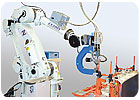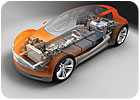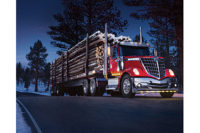
Automakers and suppliers have been focusing on vehicle weight for decades. But, rising fuel prices and strict government fuel-economy mandates are forcing the industry to explore new applications for lightweight materials, such as aluminum, composites and magnesium.
Unfortunately, this trend also poses numerous joining challenges to engineers. For example, many engineering problems involving lightweight materials cannot be solved using conventional threaded fasteners due to the thinness or brittleness of the material being assembled.
The Energy Independence and Security Act of 2007 and the new corporate average fuel economy (CAFÉ) law require automakers to increase average fuel economy by 40 percent between now and 2020. While much of the improvement will be achieved by boosting the efficiency of engines and transmissions, lightweight materials will also play a key role.
Lowering vehicle weight is a key enabler for reducing CO2 emissions. Approximately 75 percent of the average motor vehicle’s fuel consumption directly relates to factors associated with weight. In fact, for every 10 percent of weight eliminated from a vehicle’s total weight, fuel economy improves by 7 percent. Lighter weight also improves acceleration, braking and overall performance. That’s why automakers have traditionally used aluminum and other materials for low-volume, high-performance sports cars.
Consumers continue to demand more and more features, such as extra comfort, safety and entertainment devices. However, as engineers have added more bells and whistles over the years, vehicles have become heavier and more complex. For instance, the typical passenger car in 1975 weighed 3,900 pounds vs. 4,050 pounds in 2007.
While overall weight has gone up over the last 30 years, automakers have actually been using more lightweight materials. Richard Schultz, a consultant at Ducker Worldwide (Troy, MI), says metallic material content dropped from 81 percent in 1975 to 76 percent in 2007, as plastics and other nonmetallic materials grew to 24 percent of vehicle content.
In the mid-1970s, iron accounted for 15 percent of a vehicle’s weight. Today, it’s just 7 percent. At the same time, plastic use has increased from 5 percent to 8 percent, while aluminum content has jumped from 2 percent to 8 percent.
As automakers produce more and more hybrid vehicles today, weight reduction is becoming a critical issue, because batteries are extremely bulky. Any time weight can be reduced, it helps extend battery range. And, with more on-board electronics used in hybrids, such as converters and control units, even wiring becomes an important factor.
According to BCC Research (Wellesley, MA), global consumption of lightweight materials, such as aluminum, plastic and high-strength steel, will grow 6 percent annually from $81 billion in 2006 to $106 billion by 2011. Unfortunately, those materials typically cost much more than steel. The gap is narrowing, however, especially as steel prices continue to skyrocket. Indeed, during the first 3 months of 2008, the price of steel rose 40 percent.
Cost reduction remains the No. 1 priority for automotive engineers, but weight reduction is close behind, according to an annual study conducted by DuPont Automotive (Troy, MI) and the Society of Automotive Engineers (SAE, Warrendale, PA). More than three-quarters (82 percent) of 2008 respondents said weight is an important material selection criteria today vs. only 66 percent in 2007. However, because of safety standards and structural issues, there’s a limit to how much weight engineers can squeeze from passenger vehicles.
Automakers around the world are scrambling to find new ways to apply lightweight materials to mass-production applications. For instance, within the next decade, Ford Motor Co. (Dearborn, MI) will shed 250 to 750 pounds from each new vehicle it develops. Daimler AG (Stuttgart, Germany) aims to make every new Mercedes-Benz model 5 percent lighter than its predecessor. Nissan Motor Co. (Tokyo) plans to make all its vehicles 15 percent lighter by 2015, which is when fuel economy on all U.S. passenger cars must improve by 25 percent under the CAFÉ rules.
Toyota Motor Corp. (Nagoya, Japan) intends to trim 10 percent off the weight of its mid-size vehicles. If Toyota’s engineering team meets its goal, when the next-generation of the popular Corolla sedan arrives in 7 years, it will weigh 30 percent less than today’s version. Engineers have been experimenting with carbon fiber composites and recently unveiled a concept car that is the same size as today’s Prius, but only weighs one-third as much.
“There is an increasing interest in the automotive industry for alternative metals and overall weight savings, especially as the cost of steel rises,” says Chris Liddiard, director of NVH and structural solutions at Henkel Technologies (Madison Heights, MI). “Aluminum, magnesium and even titanium have been in play for years, but held back to a degree by material cost and processing issues.
“At the moment, Europe is probably more advanced in the use of lightweight materials,” notes Liddiard. “Asian-based OEMs, primarily the Japanese, take a purely design-in approach by introducing a step-by-step weight-saving concept at the design phase. We’ve seen more aluminum and composite applications, such as hoods and decklids, from Europe and Japan.
“North America has employed the same applications, but not to the same extent,” adds Liddiard. “There seems to be a shift among OEMs to consider innovative weight-saving materials up front in the design phase. North American [automakers are] now evaluating magnesium for front ends and closure panel inners, and aluminum for hoods.”

Aluminum Pros and Cons
For many decades, aluminum has been popular with the aerospace industry. However, in the 1990s, automakers began increasing their use of aluminum in an effort to reduce vehicle weight.Traditionally, automotive engineers shied away from aluminum because of cost concerns and safety issues. As a result, aluminum-intense applications have been concentrated in low-volume performance vehicles, such as the Aston Martin Vanquish, the Audi A8 and the Jaguar XL.
However, aluminum can now be found across all vehicle segments, including family sedans and sport utility vehicles (SUVs). It is widely used in engine blocks, engine cradles, hoods, wheels and bumpers. The Aluminum Association (Arlington, VA) claims that North American vehicles contain an average of 327 pounds of aluminum.
Aluminum offers a 40 percent to 50 percent weight reduction compared with steel and cast iron. While several European automakers have built all-aluminum bodies, they are still primarily made out of steel, which remains the most cost-effective way to get a crash-resistant structure.
“Body structure is the holy grail that the steel and aluminum guys are battling over,” says Schultz. “However, several manufacturers, such as BMW and Honda, are doing a nice job of mixing aluminum with high-strength steel.”
Aluminum offers great potential for weight savings, especially in weight-intensive body panel applications. But, the auto industry is not ready for widespread use of aluminum.
“It will be at least 3 to 5 years before we’ll see full aluminum bodies in family sedans,” predicts Randall Scheps, director of ground transportation at Alcoa Inc. (Pittsburgh). “Several bottleneck to high-volume production still need to be addressed, such as spot welding cycle times and cost.
“Until then, we’ll continue to see more steel and aluminum hybrids, in addition to more applications involving hang-on parts,” says Scheps. “Doors are one area that is being investigated, but it’s a very complex part.”
Engineers at Ford recently turned to aluminum to replace steel in front brake calipers on the Focus compact sedan, which resulted in an 8 percent weight savings. They are also planning to increase use of aluminum in hoods and lift gates.
General Motors Corp. (GM, Detroit) is using aluminum to produce hoods for vehicles such as the Buick Enclave, Cadillac CTS, Cadillac STS and GMC Acadia. The automaker also uses the lightweight material to build the Chevy Tahoe Hybrid and GMC Yukon Hybrid. As a result, the body of the hybrid SUVs is approximately 400 pounds lighter than a standard model. The use of aluminum helps GM offset the weight of the hybrid drive, battery pack and related hybrid hardware.
Mass-producing cars out of aluminum presents significant challenges. While aluminum offers high strength-to-weight ratios, it isn’t as ductile as steel.
However, aluminum is one of the easiest metals to join ultrasonically, so it lends itself to seam welding, spot welding and other structural applications. Sonobond Ultrasonics (West Chester, PA) has worked with Ford to develop equipment for welding large aluminum parts. It created C-frame spot welders equipped with single and dual ultrasonic heads.
The dual unit “reduces the weld energy and weld time required in making a weld to about half that needed for a single head,” says Janet Devine, Sonobond’s president. “It also dramatically reduces the tendency toward tip sticking of aluminum parts, as well as deformation of the part welded.”
In addition to hood and powertrain applications, aluminum is popular for chassis and suspension components. However, the main challenge in aluminum joints is designing fasteners that provide adequate mechanical strength without introducing galvanic corrosion.
“The solution is stronger aluminum fasteners or plating that acts as an insulator or barrier between steel fasteners and the material,” claims Bob DeVoe, director of sales and marketing at Acument Global Technologies Inc. (Troy, MI).
For example, self-piercing rivets are used extensively on structural components of the aluminum frame of a popular American sports car. “[They are] applied on reinforced ribs on hoods and trunks, door posts, and wherever thin aluminum needs structural strength,” DeVoe points out.
Adhesive can also be used to join aluminum parts. “There appears to be no real challenges in [bonding] aluminum and there may be certain benefits over typical joining techniques such as welding,” claims Liddiard. “Due to oxide layer resistance, joining aluminum to dissimilar metals with welding can introduce corrosion issues, which can be overcome by using adhesives. Differences in thermal expansion also have to be taken into account during the design phase.”

Composite Challenges
According to the recent DuPont-SAE study, automotive engineers are extremely interested in using carbon-fiber composites. More than 60 percent of respondents believe that advanced composites will be the most important material in the auto industry during the next 10 years, far ahead of other lightweight materials such plastic, aluminum and magnesium.Carbon-fiber composites weigh about one-fifth as much as steel, but are comparable in terms of stiffness and strength, depending on fiber grade and orientation. They have the potential to reduce vehicle weight by as much as 60 percent. The aerospace industry is using the technology to assemble lightweight airplanes, and their lessons-learned are expected to trickle down to the auto industry.
However, the drawback to composites is their steep price tag; they currently cost much more than steel. Carbon-fiber parts also take longer to produce than traditional steel stampings, which can be punched out in seconds. To make composite parts, layers of carbon fiber monofilaments must be wound and woven into fabric sheets. Then, the sheets are laid into molds that are baked at high temperatures in huge ovens.
Nevertheless, there has been slow but steady growth in the use of composites in automotive components, largely due to their combination of light weight and great strength. Current uses include hood covers, rear floors, fender brackets, front end systems and pickup boxes. Some manufacturers are beginning to use composites for under-the-hood applications, such as valve covers.
The Chevrolet Corvette is one of the best-known examples of carbon-fiber technology. The high-performance Corvette ZR1 features a wide variety of carbon-fiber parts, such as a roof, front fenders, spoilers and side rocker panels, which make it 35 pounds lighter than a standard Corvette. Other sporty vehicles that use composite technology include the Dodge Viper, the Pontiac Solstice and the Saturn Sky.
Keith Bihary, chairman of the Automotive Composites Alliance (Arlington, VA), claims that composites offer unrivaled corrosion resistance when exposed to moisture and road salt. They also offer a limitless depth-of-draw range.
“Stamped metals get thinner as they are drawn to form vertical walls,” says Bihary. “Composites offer the ability to maintain a constant cross-sectional thickness over the entire part.
“Composites also allow manufacturers to consolidate their parts count,” adds Bihary. “For instance, a complex trunk structure could be reduced to a single mold. Composites would replace six to eight metal stampings and save up to 70 percent in tooling investment.”
In addition, Bihary says many shapes that are impossible or economically prohibitive to form in steel and aluminum can be produced with relative ease by using composites. For instance, when GM engineers recently designed the Buick Riviera concept car, they used carbon fiber in all body panels. That allowed them greater flexibility through reduced mass and added strength. As a result, the engineers were able to create sharp, tight radius curves across the body surface.
Bihary says the heavy-duty truck industry is already using a large amount of composite materials. “Compared to automakers, they’re way ahead in the game,” he points out.
Japanese automakers have also jumped on the bandwagon. Honda, Mazda and Mitsubishi currently offer vehicles equipped with carbon fiber driveshafts. Nissan’s GT-R sports car features a carbon fiber engine underguard and radiator panel.
At the Chicago Auto Show earlier this year, Toyota unveiled its 1/X concept vehicle, which offers a glimpse into the next era of ultra-lightweight materials. The 926-pound vehicle uses carbon-fiber reinforced plastic throughout the body frame. The roof is made from a bio-plastic derived from kenaf and ramie plants, while the seats are made from a polyester fiber that functions like a spring. Because of the light weight, engineers were able to equip the car with small, thin wheels.
Three Japanese companies currently control 70 percent of the global carbon-fiber market: Toray Industries Inc. (Tokyo), Teijin Ltd. (Osaka, Japan) and Mitsubishi Rayon Co. (Tokyo). Toyota has reportedly formed a joint-venture with one of the companies.
Toray is the largest player. It recently opened a $24 million automotive center in Nagoya, which is where Toyota is based. Toray engineers hope to develop low-cost carbon-fiber composites that can be used for body panels and structural parts. Another goal is to develop a 10-minute molding process, which would dramatically streamline throughput.
Because composites can’t be welded, there’s a big need for adhesives and fasteners. “The main challenge is that some composite and plastic parts need special adhesives to overcome surface energy effects that cause issues with adhesive bonding,” says Liddiard. “Processing composites can be energy intensive and costly. Therefore, adhesives that allow for the reduction of process heat would be invaluable. Both epoxy and urethane chemistries are effective approaches.”
Composites also pose special challenges when using mechanical fasteners. They are much more brittle than typical plastics, which means threaded fasteners often do not perform as needed.
“Composite materials, although made up of polymers and resins, present fastening challenges because of the filler or strengthening material, such as fiberglass, which creates difficulty for thread-forming screws,” explains Ken Gomes, vice president of marketing and engineering at Research Engineering & Manufacturing Inc. (REM, Middletown, RI), which specializes in designing fasteners. “The use of thread-cutting screws or pretapping creates other problems. For nonpermanent assemblies, special design thread-forming screws for plastics should be considered.”
Blind fasteners are also effective in joining composites. For instance, bulbing and split-tail formation blind fasteners form large backside load-bearing areas.

Magnesium Muscles Into Motown
Another lightweight material that is slowly being adopted by automakers is magnesium. It is attractive to engineers because it’s 36 percent lighter than aluminum and 78 percent lighter than steel, yet it has a better strength-to-weight ratio than either metal. Magnesium is also highly moldable, and parts can be die-cast with walls as thin as 0.8 millimeter.
“Magnesium has the potential to be a real enabler,” says Dr. Mark Verbrugge, director of GM’s Materials and Processes Laboratory. “It has the ability to enhance design freedom and performance, in addition to reducing mass.”
Magnesium is of particular interest for automotive applications, because it can be joined by a wide variety of assembly processes, including adhesives, fasteners and welding. Components made from the lightweight material include engine cradles, radiator supports, instrument panel cross-bar beams, transmission housings, seat structures, support brackets, brake and clutch pedals, bumper support beams and airbag housings.
However, the typical American-made vehicle contains less than 12 pounds of magnesium. Once the correct market infrastructure is in place, Verbrugge believes magnesium content could increase to as much as 350 pounds per vehicle by 2020.
“The anticipated use of magnesium in engines, transfer units and transmissions where aluminum is currently being used will achieve a further 33 percent increase in weight savings,” adds Gomes. “Several chassis applications in the future could be manufactured from magnesium.”
According to Gomes, using threaded fasteners in magnesium presents several challenges to manufacturing engineers. “The lack of ductility in magnesium limits the ability of thread-forming screws to function,” he points out. “The cold flow and thermal expansion rate of magnesium creates challenges in maintaining joint clamp load in applications subject to extreme heat cycles. Magnesium applications using steel screws have to be designed to prevent accelerated stress corrosion.”
“In the early stages of studies that are being conducted, the issues and advantages of magnesium appear to be similar to aluminum,” says Henkel’s Liddiard. “With both aluminum and magnesium, the oxide layers will still play a role in determining the efficacy of a durable bond. Corrosion of magnesium in an automotive application comes primarily from galvanic action in connection with steel.
“Adhesion to magnesium depends on the alloy composition,” notes Liddiard. “Therefore, application-specific testing is recommended. The advantage of adhesives is that they will not only bond components but will also interrupt the corrosive action.”
To learn more about lightweight material use in the auto industry, search for these articles on ASSEMBLY’s Web site:
- Lotus Races to Tackle the Lightweight Challenge.
- Magnesium Use Will Increase in Auto Industry.
- New Process Reduces Cost of Titanium Auto Parts.
- Plastic Is a ‘Heavy’ Weight Champion.
- Steel Still Rules.
- The Ultimate Lightweight Driving Machine?

